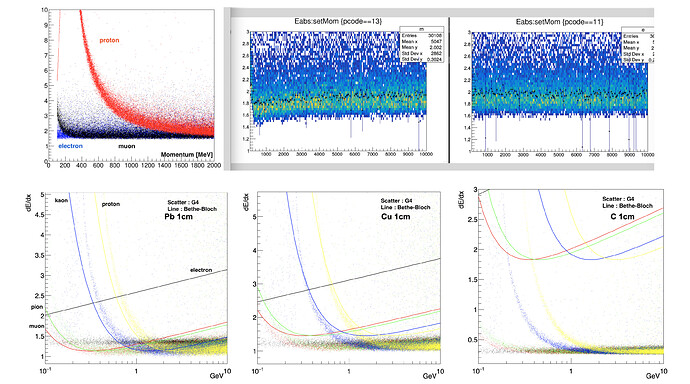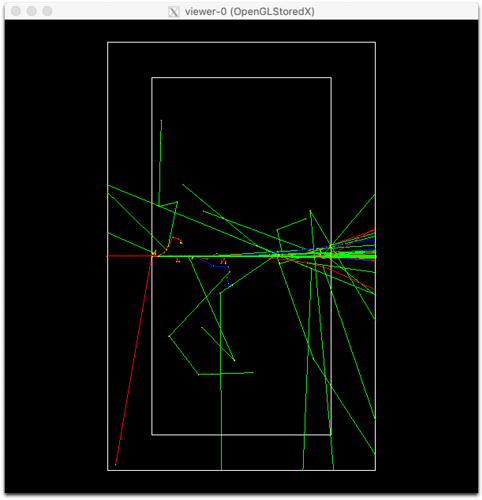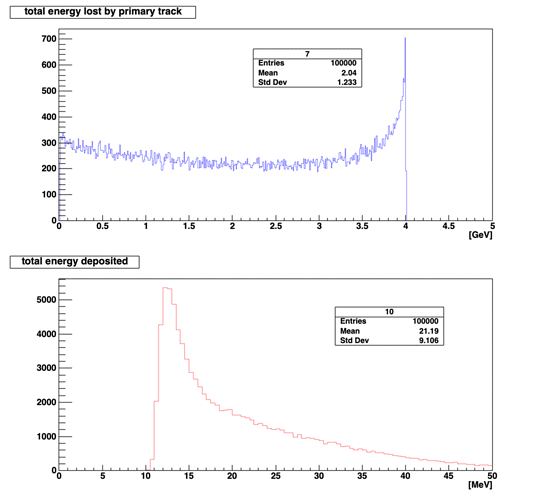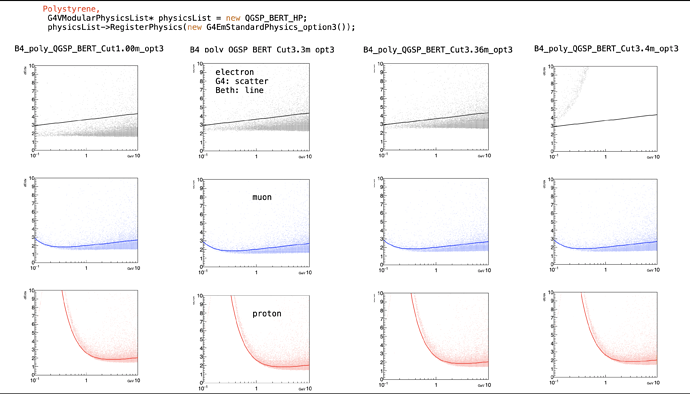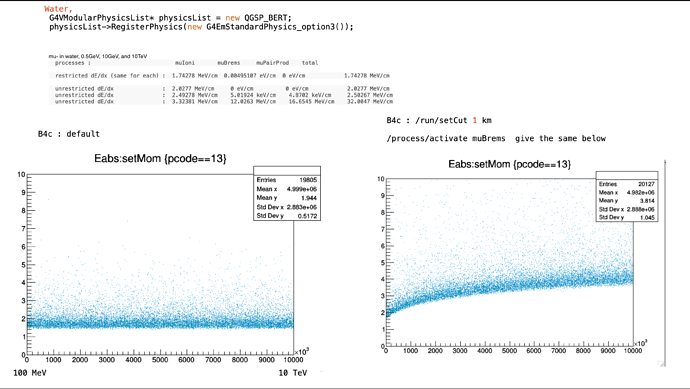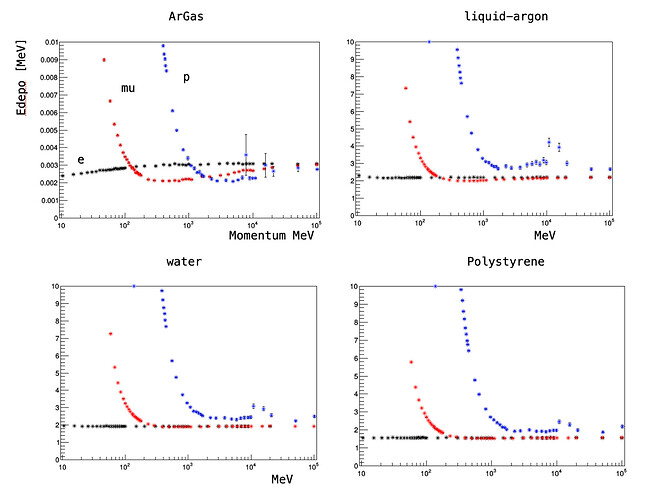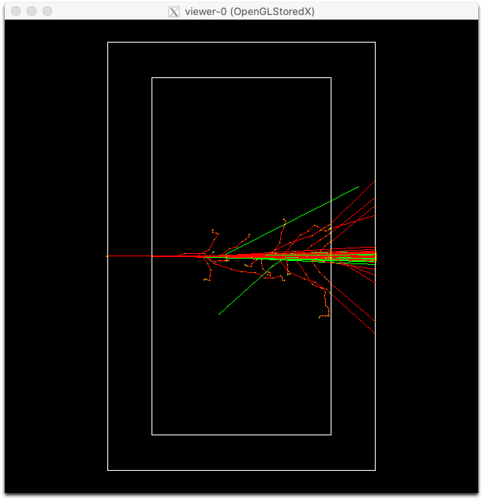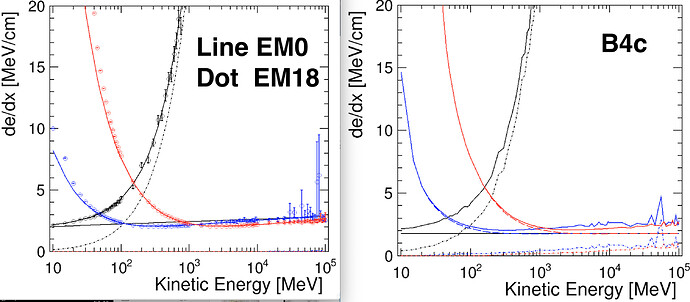I also checked behaviors of the secondary with setCut of 1 mm and 1 km as shown in a pic below where 10 events are generated for the both.
_
_
_
setCut 1 mm:
Energy deposit of a primary seems to be too small even at high momentum as I reported in the past. But, I can see radiated gammas, and I can see a process like Compton Scattering: “e → gamma → e- + gamma”.
In fact, , brems is hundled. but dedx is 1.7 MeV for e- of 500 MeV in water
* G4Track Information: Particle = e-, Track ID = 1, Parent ID = 0
*********************************************************************************************************
Step# X(mm) Y(mm) Z(mm) KinE(MeV) dE(MeV) StepLeng TrackLeng NextVolume ProcName
0 0 0 -12 500 0 0 0 World initStep
1 0 0 -10 500 8.4e-26 2 2 Abso Transportation
2 0 0 -0.01 498 1.66 10 12 Gap Transportation
3 1.16e-05 6.44e-06 1.08e-16 498 0.00249 0.01 12 Abso Transportation
4 0.000918 -1.78e-05 1.44 497 0.385 1.44 13.5 Abso eBrem
5 0.00369 -0.00828 10 496 1.53 8.56 22 Gap Transportation
6 0.00374 -0.00831 10 496 0.00111 0.01 22 World Transportation
7 0.0151 -0.0141 12 496 8.39e-26 2 24 OutOfWorld Transportation
Absorber: total energy: 3.575904989092408 MeV total track length: 2.000012698153836 cm
_
_
_
_
setCut 1 km:
Energy deposit of a primary seems to be reasonable when comparing it with other many plots of dedx in water existing in WEB. However…, I can not see gamma radiation, and I can not see processes like Compton Scattering… I can see only the primary electron…
In fact, bremsstrahlung is not hundred… (@1/Feb.)
* G4Track Information: Particle = e-, Track ID = 1, Parent ID = 0
*********************************************************************************************************
Step# X(mm) Y(mm) Z(mm) KinE(MeV) dE(MeV) StepLeng TrackLeng NextVolume ProcName
0 0 0 -12 500 0 0 0 World initStep
1 0 0 -10 500 8.4e-26 2 2 Abso Transportation
2 0 0 -0.01 487 12.7 10 12 Gap Transportation
3 1.19e-05 6.6e-06 1.08e-16 487 0.0108 0.01 12 Abso Transportation
4 0.0114 0.00681 10 465 22 10 22 Gap Transportation
5 0.0114 0.00677 10 465 0.00881 0.01 22 World Transportation
6 0.00877 -0.00228 12 465 8.36e-26 2 24 OutOfWorld Transportation
Absorber: total energy: 34.76002329385038 MeV total track length: 2.000015923042318 cm
Soft gamma radiation is not handled as gamma?? I mean, trajectory is probably ignored (as mentioned in user tutorial), in this case, I can not simulate EM-shower in water or scintillator??
So, there is no way to establish both of the reasonable dedx and gamma radiation??
_
_
_
_
EmTest18 looks fine as far as looking summary. But, it is not consistent with track info…
_
Material : Water
Range cuts : gamma 1 mm e- 1 mm e+ 1 mm proton 1 mm
Energy thresholds : gamma 2.94056 keV e- 351.877 keV e+ 342.545 keV proton 100 keV
*********************************************************************************************************
* G4Track Information: Particle = e-, Track ID = 1, Parent ID = 0
*********************************************************************************************************
Step# X Y Z KineE dEStep StepLeng TrakLeng Volume Process
0 -5 mm 352 um 3.69 mm 500 MeV 0 eV 0 fm 0 fm Water initStep
1 998 um 352 um 3.69 mm 481 MeV 1.06 MeV 6 mm 6 mm Water eBrem
2 5 mm 352 um 3.69 mm 481 MeV 594 keV 4 mm 1 cm Water OutOfWorld
===========================================================
The run was 1 e- of 500 MeV through 1 cm of Water (density: 1 g/cm3 )
===========================================================
TrackLength= 1 cm nb of steps= 2 stepSize= 5 mm
d-rays : eLoss/primary= 0 eV nb of d-rays= 0 <Tkin>= 0 eV Tmin= 2.8802e+295 J Tmax= 0 eV
<Brems>
gamma : eLoss/primary= 17.577 MeV nb of gammas= 1 <Tkin>= 17.577 MeV Tmin= 17.577 MeV Tmax= 17.577 MeV
<Ionize>
deposit : eLoss/primary= 1.6536 MeV <dEcut > table= 1.7446 MeV ---> simul/reference= 0.94784
total : eLoss/primary= 19.231 MeV <dEfull> table= 15.357 MeV ---> simul/reference= 1.2523
_
_
_
OK, to get dedx of the primary, I also have to get energy of 2ndary like
//energy spectrum of secondaries
//
G4double energy = track->GetKineticEnergy();
G4bool charged = (track->GetDefinition()->GetPDGCharge() != 0.);

